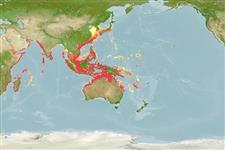Classification / Names
Common names from other countries
Main reference
Size / Weight / Age
Max length : 70.0 cm TL male/unsexed; (Ref. 48635); common length : 25.0 cm TL male/unsexed; (Ref. 5450)
Environment
Marine; freshwater; brackish; demersal; depth range 15 - 115 m (Ref. 12260)
Climate / Range
Tropical; 26°C - 29°C (Ref. 4959), preferred 27°C (Ref. 107945); 40°N - 27°S, 32°E - 170°E
Distribution
Indo-West Pacific: Red Sea to the Philippines (but without record from the Persian Gulf), north to southern Japan (Ref. 559), and south to northern Australia. Also reported from New Caledonia (Ref. 11889). Recently recorded from Oman (Ref. 11441) and Kuwait (Ref. 80050).
Countries | FAO areas | Ecosystems | Occurrences | Introductions
Short description
Dorsal
spines
(total): 12;
Dorsal
soft rays
(total): 13-14;
Anal
spines: 3;
Anal
soft rays: 7. Body ovate; head profile almost straight. Mouth small; lips not thickened; two pores and a central groove under the chin. No antrorse spine before the dorsal fin origin; notch between the spinous and soft-rayed portion of the dorsal fin shallow. Color is generally silver-mauve to fawn above, white below. Small specimens with numerous spots aligned horizontally or fused into horizontal lines; large specimens plain or with scattered charcoal scale spots on back and upper sides; the snout is dark brown; the upper operculum charcoal or purplish.
IUCN Red List Status (Ref. 115185)
Threat to humans
Harmless
Human uses
Fisheries: commercial
Tools
Special reports
Download XML
Internet sources
Estimates of some properties based on models
Phylogenetic diversity index
PD50 = 0.5000 many relatives (e.g. carps) 0.5 - 2.0 few relatives (e.g. lungfishes)
Trophic Level
3.5 ±0.3 se; Based on diet studies.
Resilience
Medium, minimum population doubling time 1.4 - 4.4 years (K=0.2-0.5; tmax=19)
Vulnerability
Moderate vulnerability (38 of 100)
Price category
